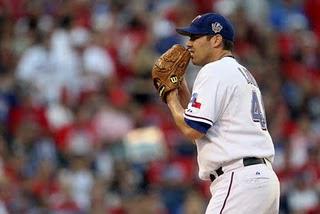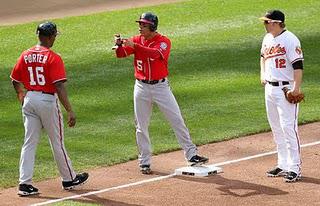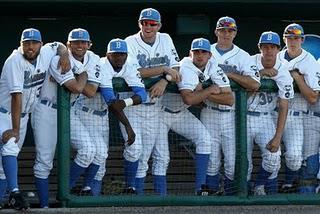As I have stated numerous times in this series on the suicide squeeze, if the offensive team hides it well, uses the proper timing, and executes the fundamentals of the bunt, there is virtually nothing a defense can do to stop the suicide squeeze. Therefore, defending the squeeze play basically involves taking advantage of any mistake the offensive team makes during the process. Defending the squeeze involves many people but the major players are the pitcher, catcher, 1st baseman, and the 3rd baseman. This last part of the Suicide Squeeze series will focus on each separately and conclude with another very profitable tip for the team on defense.

A pitcher MUST look at the runner at third base
BEFORE starting his delivery
The Pitcher. The first tip for all pitchers involves peaking at the runner at third prior to the pitch. Click HERE to read a previous post for more details on this topic. When it comes to a pitcher's delivery, it is generally a good idea to go from the stretch position with less than two outs and a runner on 3rd base. I mentioned in Part 4 that a runner at 3rd has a more difficult time getting a good jump towards home plate when a pitcher is in the stretch. However, when a pitcher goes from the wind-up, a runner may be too anxious and leave too early. The wind-up gives the pitcher more time to adjust his pitch if this occurs. Should the batter or runner tip off the squeeze too early the pitcher has a couple options. First, the pitch can be thrown in a pre-determined location like up and away or even a normal pitch out location. The key is that both the pitcher and the catcher have to know beforehand where the pitch will be thrown. The second option poses an ethical dilemma that involves throwing at the batter. Should the pitch hit the batter, a dead ball is the result and the runner will have to go back to third base. You would normally only see this strategy if the runner on third is the game-winning run. It goes without saying that there is a significant danger in telling a pitcher to take this option. Should a batter get seriously hurt and it comes out that the coach instructed his pitcher to purposely hit the batter, the coach can understandably be in a world of trouble. I am not condoning this play. I'm simply stating that it has been used as an option.Fielding a squeeze bunt and tossing it to the catcher is obviously an important responsibility for any pitcher. PFP (Pitchers Fielding Practice) should include drills that help prepare pitchers to do this properly.The Catcher. Much of what the catcher does involves looking for clues as to when it may be coming. Observing the batter is his priority. Watching for changes like where the batter positions his feet in the box or how the batter acts after he gets the sign from the third base coach would be a catcher's responsibility.The 1st Baseman. Like any bunt situation, the first baseman's job is to charge towards home plate when able and hopefully be in a position to make a play at home on a poorly bunted ball.
Be in the area when the coach is talking to the
runner at third base.
The 3rd Baseman. The role of the third baseman is similar to the first baseman in that when the play is identified, he charges towards home plate. However, there is something else the third baseman can do prior to the pitch. Many times a third base coach will talk to the runner at third before and/or after the sign is given to insure that he knows the squeeze is on. As a result, it's not a bad idea for the third baseman to wonder over towards the third base bag before each pitch in an effort to hear what the coach is saying. There is nothing unethical about this. The third baseman can go anywhere he wants as long as he is not interfering with the runner.
If you watch carefully, these guys can
be your best source for information.
Final Tips. In this series, a lot of attention has been given to watching the third base coach, the runner at third, and the batter for clues that a squeeze might be coming. That being said, there is another area that should be watched. The offensive team's bench. In my experience, I believe this to be the most profitable area to watch. The major players involved in the squeeze play - the third base coach, the runner, and the batter - basically know that they are being watched and normally conduct themselves accordingly. However, players on the bench sometimes make the mistake of assuming that nobody is watching them. Personally, I don't spend much time trying to decipher signs from the third base coach. I usually just watch the other teams' bench and look for anything out of the norm. To follow what's happening in the game, many players on the bench pay attention to the signs given by the third base coach. Players who all of a sudden become very alert after the sign is given may be indicating that a play is about to occur. You may see a bench player elbow a kid next to him as if to say "Pay attention. The squeeze is on." An on-deck batter may stop his routine so that he can watch what is about to occur. There are many variations. The key is to watch them throughout the game so you can pick up their normal behaviors. You can then compare that with what you see in big situations later in the game and hopefully pick up anything out of the ordinary. The suicide squeeze can be a valuable play for any offense. Practicing it and paying attention to the many little things involved can pay dividends for both the offensive and defensive teams.




